Design a Zen Japanese Bedroom in 6 Easy Steps
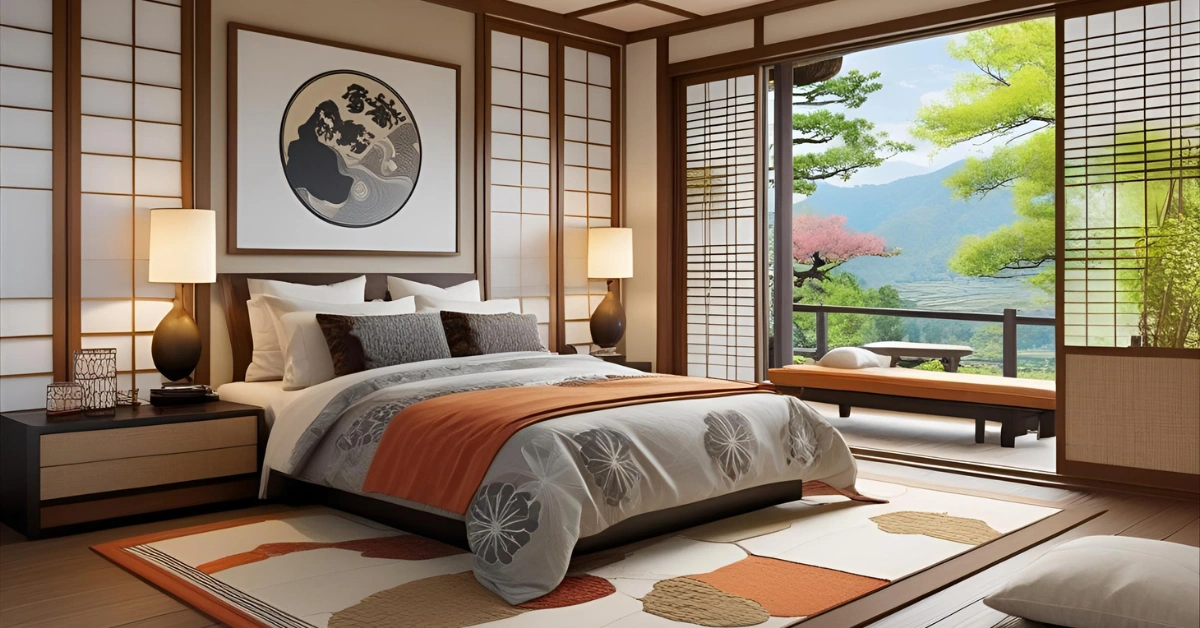
Feeling overwhelmed by a cluttered, uninspiring bedroom? Many people struggle to create a restful space that truly feels like an escape from daily stress. A Japanese bedroom, rooted in Zen principles and minimalist aesthetics, offers a solution by blending simplicity, nature, and functionality. This guide will walk you through creating a Japanese bedroom that’s both calming and stylish, with practical tips and fresh ideas to make your space a personal sanctuary.

Whether you’re redesigning a small apartment or a spacious master suite, this article provides actionable steps, design inspiration, and expert insights to help you craft a Japanese bedroom that promotes peace and balance.
The Essence of a Japanese Bedroom
A Japanese bedroom is more than a place to sleep it’s a haven of tranquility inspired by Zen philosophy and traditional Japanese culture. This design style prioritizes simplicity, natural materials, and a clutter-free environment to foster relaxation.
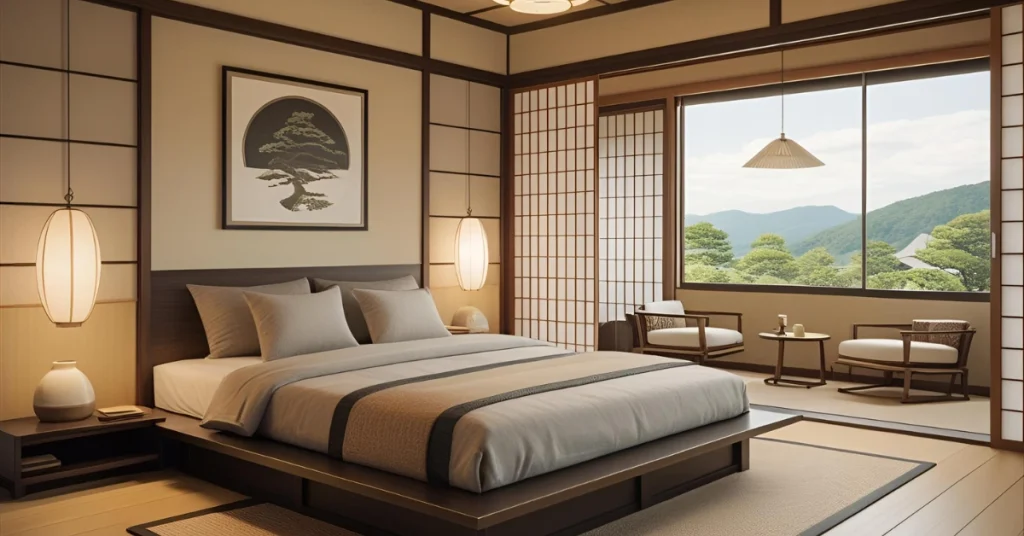
Core Pillars of Japanese Bedroom Design
- Simplicity: Focus on essential items, avoiding excess decor or furniture.
- Natural Textures: Use wood, bamboo, and cotton for an organic feel.
- Soft Colors: Neutral tones like beige, white, and taupe create a soothing vibe.
- Nature Connection: Incorporate plants or natural views for harmony.
- Purposeful Design: Every element serves a function, blending form and utility.

“A Japanese bedroom invites you to slow down and find calm in every detail.” – Aiko Suzuki, Interior Design Specialist
Why Opt for a Japanese Bedroom?
This design style offers unique benefits that make it ideal for modern living. Here’s why a Japanese bedroom stands out:

- Calms the Mind: Minimalist aesthetics reduce visual noise, promoting better sleep.
- Timeless Appeal: Its classic style remains relevant across trends.
- Space-Saving: Low furniture and open layouts work well in small rooms.
- Eco-Conscious: Natural, sustainable materials align with green living.
A 2023 report from the Japan Design Council found that minimalist-inspired bedrooms increased occupants’ relaxation by 22%, highlighting the power of a Japanese bedroom to enhance well-being.
Must-Have Features for a Japanese Bedroom
To capture the essence of this style, focus on these key elements. Each contributes to the serene, balanced atmosphere that defines a Japanese bedroom.
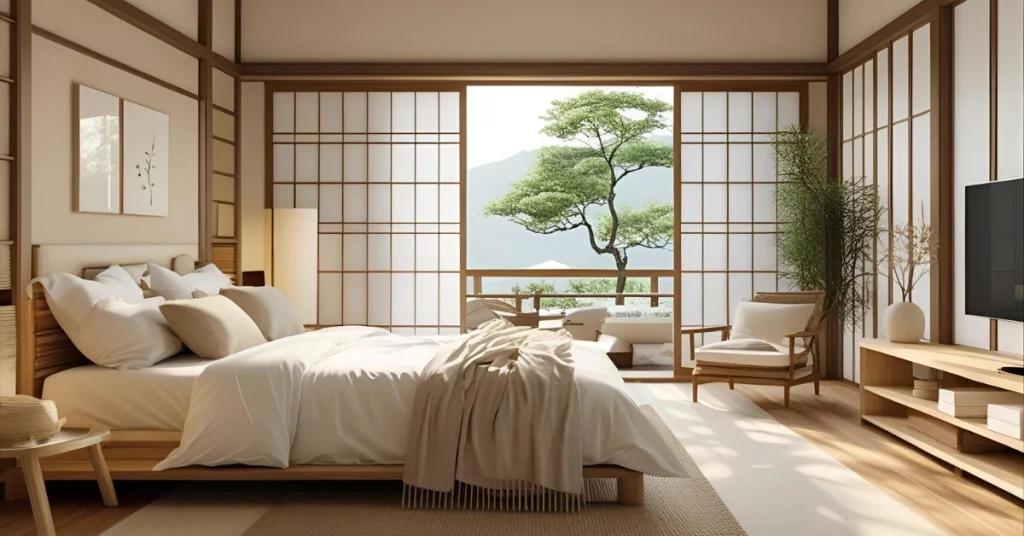
1. Grounded Furniture Choices
Japanese bedrooms often feature low-profile furniture, such as futons or platform beds, to create a sense of grounding and maximize space.
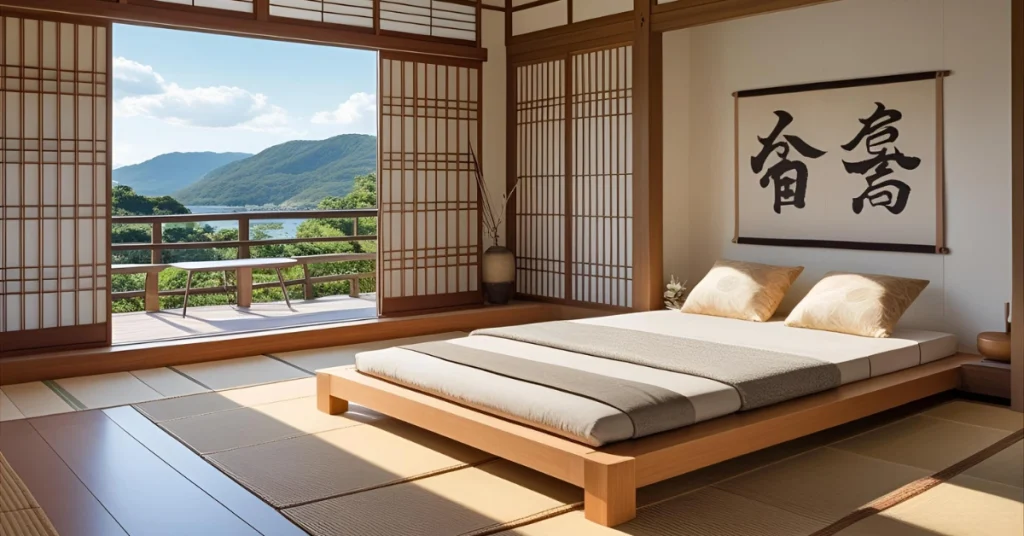
- Futon or Platform Bed: Choose a foldable futon or a low wooden bed frame.
- Tatami Flooring: Woven straw mats add texture and authenticity.
- Compact Tables: A low table for tea or reading doubles as a nightstand.
Design Tip: If a floor-level futon feels too traditional, opt for a low platform bed with clean lines for a modern twist.
2. Organic Materials
Natural materials are central to Japanese design, bringing warmth and authenticity to the space.
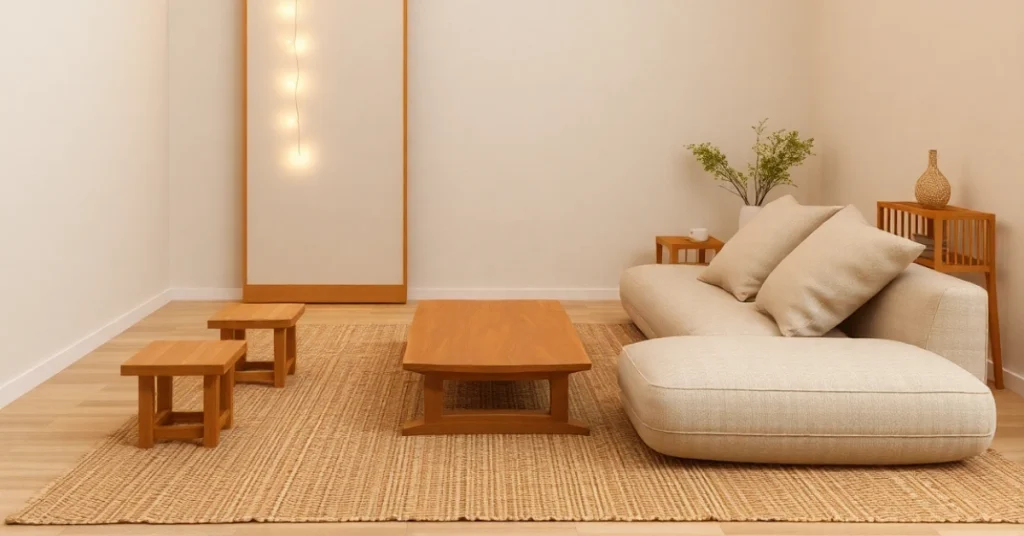
- Wood: Cedar or oak furniture adds durability and a natural aesthetic.
- Bamboo: Use for accents like shelves or light fixtures.
- Rice Paper: Shoji screens diffuse light softly, enhancing privacy.
Real-World Example: A homeowner in Osaka used reclaimed bamboo for a custom headboard, paired with tatami mats, creating a warm, authentic Japanese bedroom.
3. Soothing Color Tones
A muted, earthy palette sets the tone for relaxation. Stick to colors like:
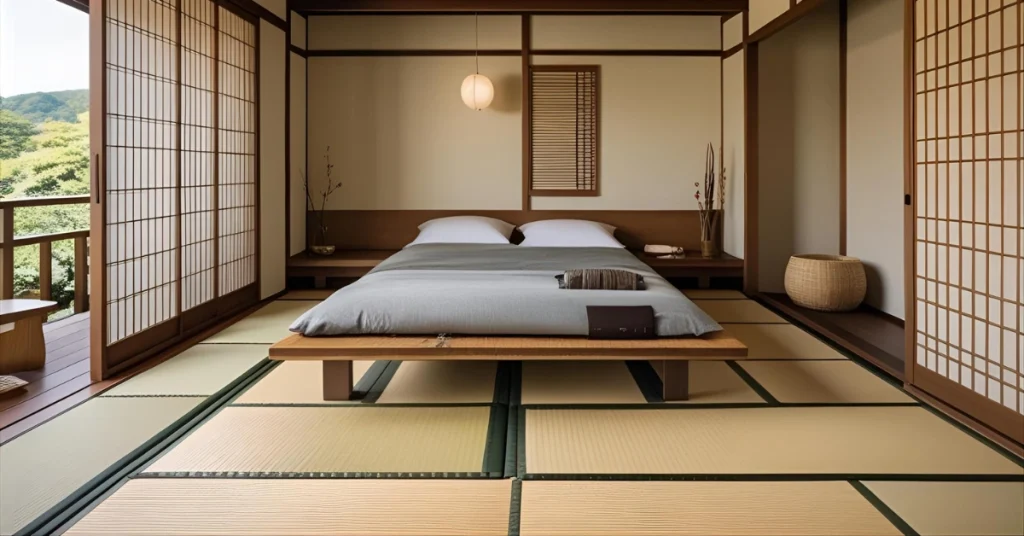
- Soft white
- Warm beige
- Light gray
- Natural brown
- Subtle olive
Pro Tip: Add a single accent color, like a moss-green throw or a navy cushion, for contrast without disrupting the calm.
4. Space-Saving Sliding Features
Sliding doors and shoji screens are practical and iconic elements of Japanese design.
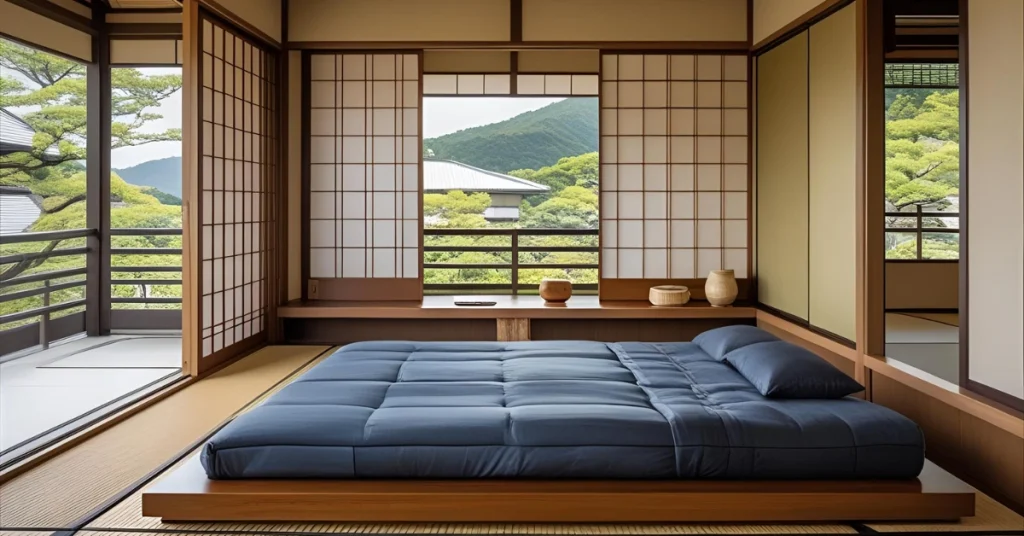
- Shoji Screens: Use as window coverings or room dividers for soft light.
- Sliding Doors: Install for wardrobes to keep the space sleek.
“Sliding doors and shoji screens bring elegance and flexibility to a room.” – Kenji Yamada, Japanese Design Expert
5. Thoughtful, Minimal Decor
Japanese design embraces ma—the beauty of empty space—where less is more.
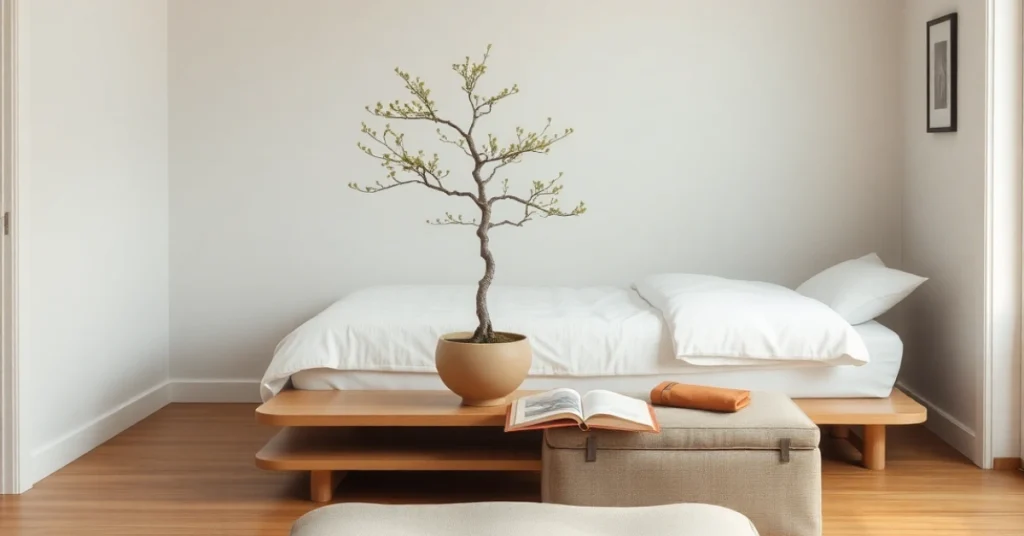
- Focal Point: Choose one item, like a bonsai or a simple vase, to draw the eye.
- Textiles: Opt for cotton or linen bedding in neutral tones.
- Clutter-Free: Keep surfaces clear, displaying only meaningful items.
Your Roadmap to a Japanese Bedroom
Follow these steps to design a Japanese bedroom that’s authentic, functional, and tailored to your space.
Step 1: Clear the Clutter
A clutter-free space is the foundation of Japanese design. Start by simplifying your room.
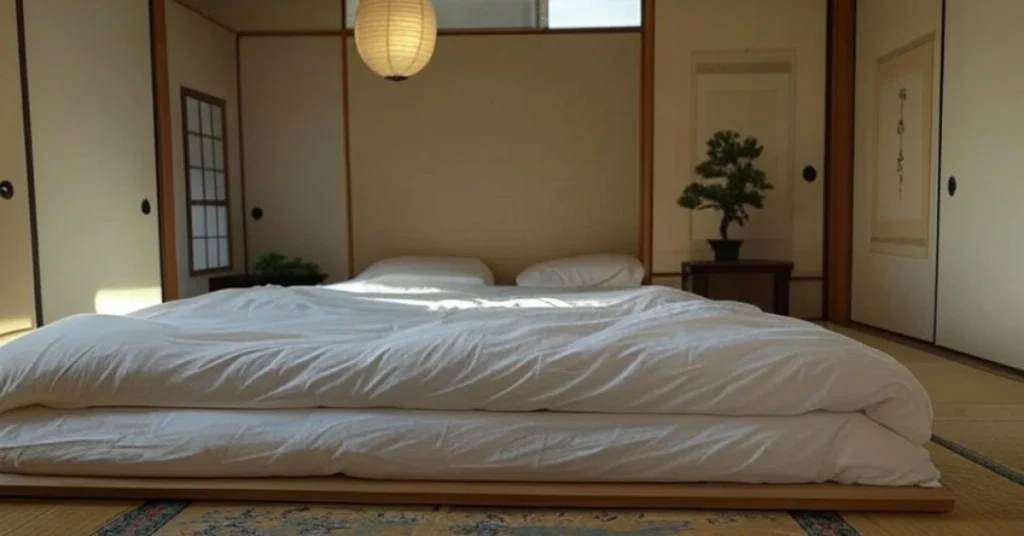
- Remove non-essential items like extra decor or furniture.
- Use hidden storage to keep personal items out of sight.
- Aim for open floor space and clean surfaces.
Step 2: Select Minimalist Furniture
Choose low, functional pieces that align with Japanese aesthetics.
| Furniture | Best Choice | Benefits |
|---|---|---|
| Bed | Futon or low platform | Creates an open, grounded feel |
| Nightstand | Small bamboo table | Functional and unobtrusive |
| Storage | Sliding-door wardrobe | Saves space, keeps things tidy |
Step 3: Embrace Nature
Incorporate natural elements to bring the outdoors in.
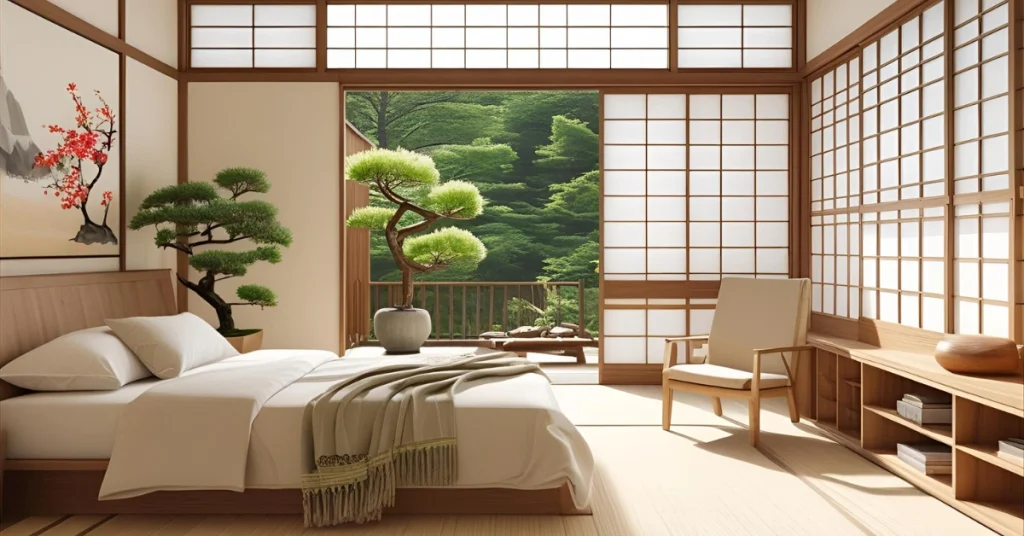
- Add a small potted plant or bonsai for greenery.
- Maximize natural light with large windows or shoji screens.
- Use unfinished wood for furniture to enhance warmth.
Pro Tip: If natural light is limited, use warm LED lamps to replicate a soft, natural glow.
Step 4: Curate a Restful Palette
Choose neutral colors for walls, bedding, and decor.
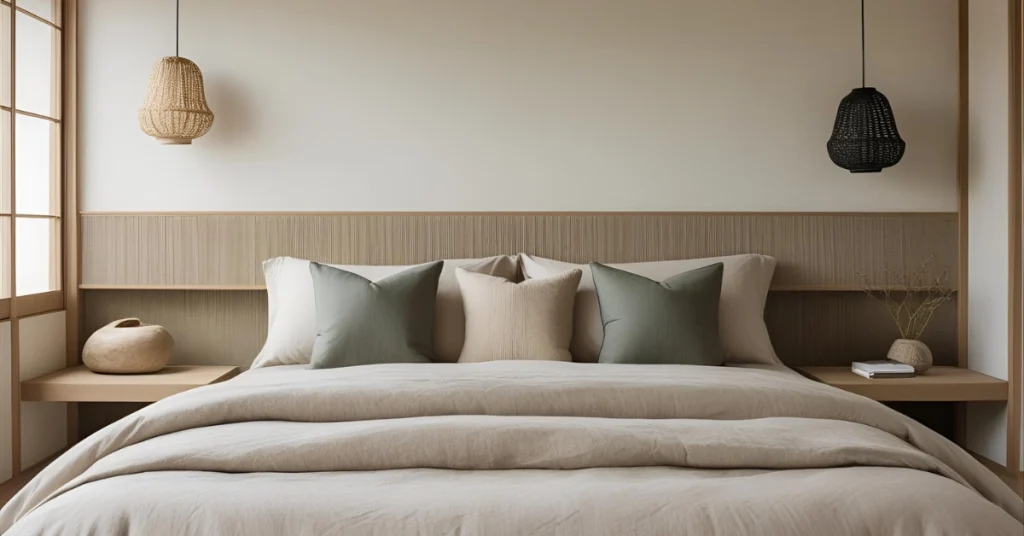
- Paint walls in off-white or light taupe.
- Select natural-fiber bedding in beige or gray.
- Add subtle accents with pillows in earthy tones like sage or charcoal.
Step 5: Add Traditional Accents
Incorporate authentic Japanese elements to elevate the design.
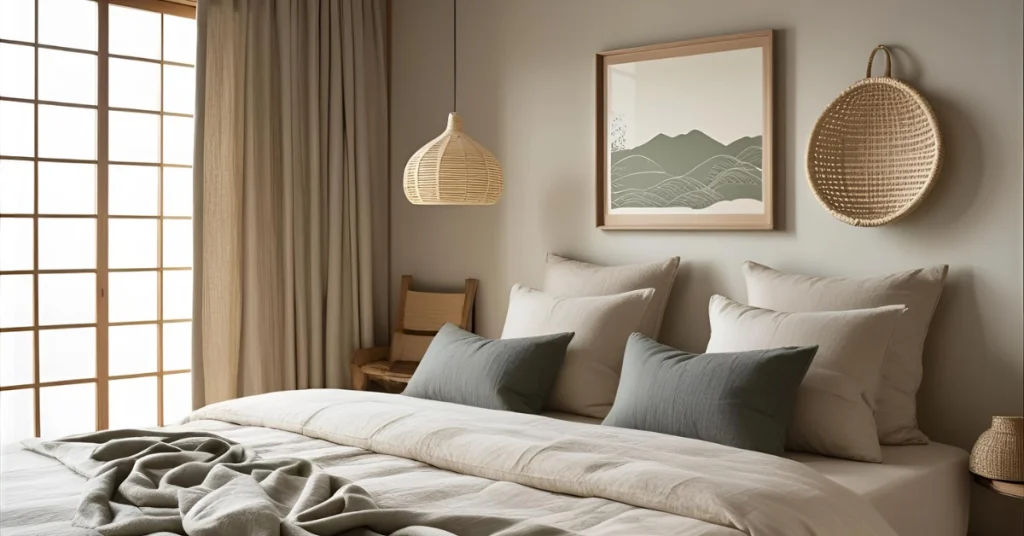
- Display a single piece of calligraphy or minimalist art.
- Use tatami-style rugs for texture.
- Create a small meditation nook with a cushion and low table.
Real-World Example: A couple in Vancouver redesigned their bedroom with a low platform bed and a shoji screen divider, creating a spacious, Zen-inspired retreat in a compact space.
Pitfalls to Avoid in Japanese Bedroom Design
Steer clear of these common mistakes to maintain the authenticity and serenity of your Japanese bedroom:
- Overloading the Space: Too many items disrupt the minimalist vibe.
- Bold Color Choices: Bright hues can clash with the calming aesthetic.
- Non-Functional Decor: Every item should have a purpose.
- Harsh Lighting: Avoid cold, bright lights; opt for warm, diffused options.
- Lack of Storage: Clutter undermines the Zen atmosphere—use smart storage solutions.
Japanese Bedroom Inspiration for Any Space
Japanese design is versatile enough to suit any room size. Here are ideas tailored to different spaces.
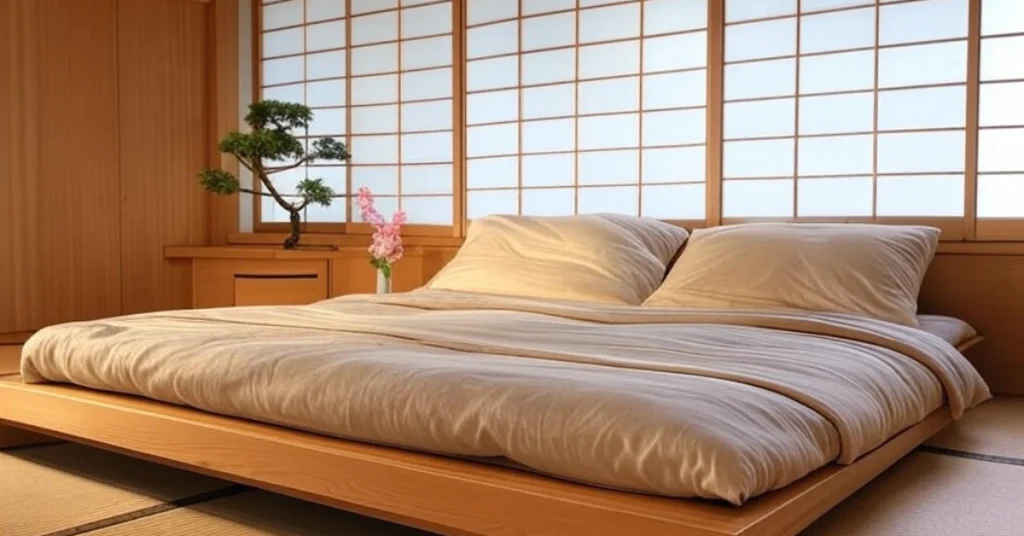
Compact Japanese Bedroom
- Use a foldable futon to free up daytime space.
- Install sliding wardrobe doors to save floor space.
- Add a single plant as a natural focal point.
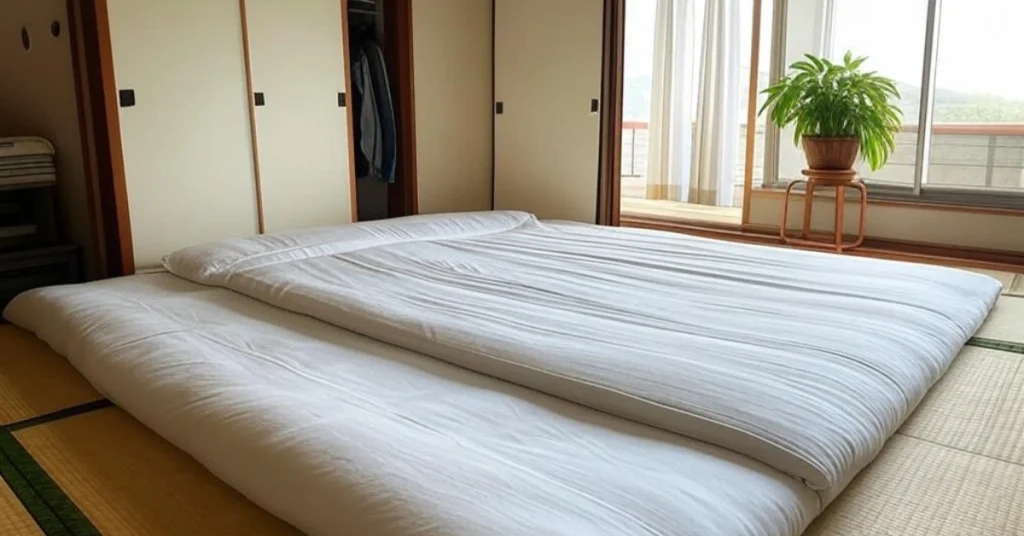
Medium-Sized Japanese Bedroom
- Choose a low platform bed with under-bed storage.
- Use a shoji screen to create a cozy reading corner.
- Hang a minimalist artwork for subtle personality.

Spacious Japanese Bedroom
- Design a tatami mat area for a traditional sleeping setup.
- Add a low tea table for meditation or journaling.
- Use multiple shoji screens to create distinct zones.
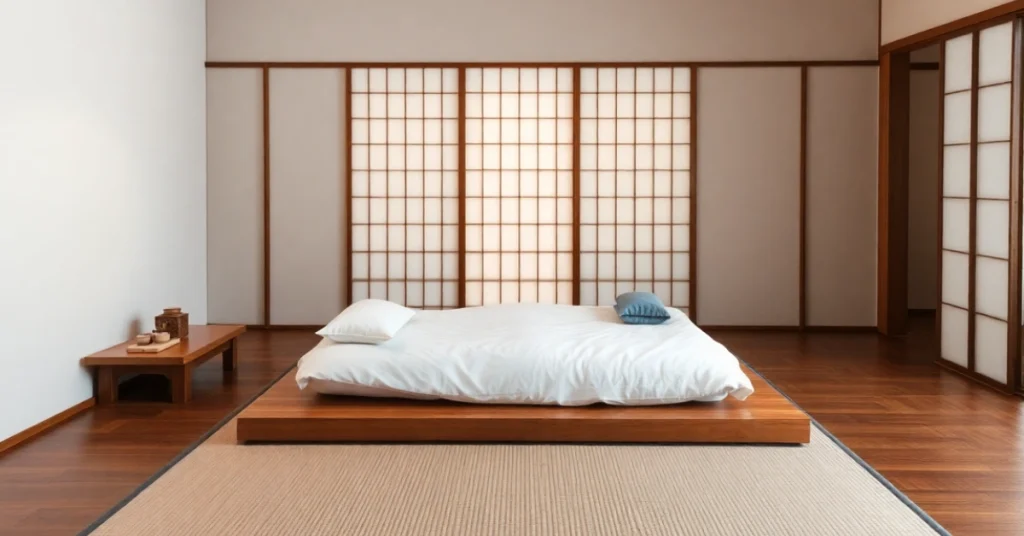
Blending Modern Comfort with Japanese Style
You can merge traditional Japanese design with modern elements for a functional, contemporary bedroom.
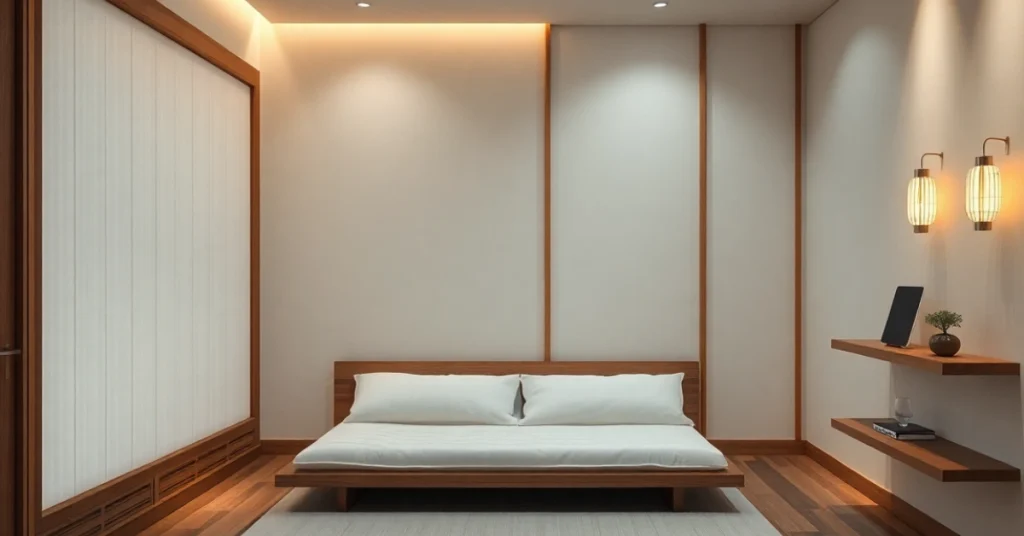
- Smart Lighting: Use dimmable LEDs to mimic lantern-like warmth.
- Hidden Tech: Incorporate charging stations in furniture to keep devices out of sight.
- Comfort Upgrades: Pair a futon with a modern memory foam layer.
Design Tip: A low wooden bed with built-in USB ports combines Zen aesthetics with modern convenience.
Affordable Ways to Create a Japanese Bedroom
You don’t need a big budget to achieve this look. Try these cost-saving ideas:

- DIY Shoji Screens: Use wooden frames and frosted acrylic for a budget-friendly alternative.
- Thrifted Furniture: Find low wooden tables or bed frames secondhand.
- Inexpensive Plants: Add affordable bamboo or succulents for a natural touch.
- Simple Bedding: Choose neutral, budget-friendly cotton or linen bedding.
Real-World Example: A student in Kyoto created a stunning Japanese bedroom using tatami-style rugs from a local market and DIY shoji screens, proving style doesn’t require a high cost.
Keeping Your Japanese Bedroom Serene
Maintain the tranquil vibe with these simple upkeep tips:
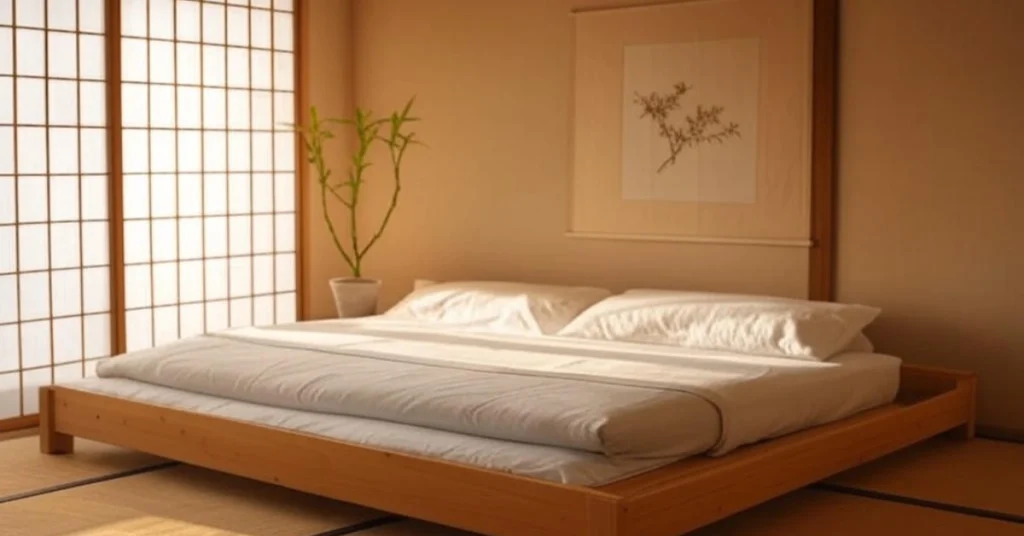
- Monthly Decluttering: Remove unnecessary items regularly.
- Tatami Care: Vacuum or wipe mats to keep them clean.
- Bedding Maintenance: Wash natural-fiber bedding with gentle detergents.
- Refresh Decor: Swap small items like plants or art seasonally.
Conclusion:
A Japanese bedroom is a perfect blend of simplicity, nature, and functionality, offering a serene escape from daily life. By embracing minimalist principles, natural materials, and thoughtful design, you can create a space that’s both timeless and uniquely yours. Whether you’re starting small or going all-in, these ideas will help you craft a Japanese bedroom that promotes peace and rest.
Ready to bring Zen into your home? Start by decluttering your space or adding a single Japanese-inspired element like a futon or shoji screen. Share your journey or get more design tips by exploring our other guides!






